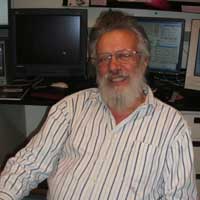Gerhard Randers-Pehrson
Research Interests
|
 |
Contact Information
|
| Academic Training | |
|---|---|
|
Undergraduate: |
B.S., Physics, Rensselaer Polytechnic Institute, Troy, NY
1966 |
| Graduate: |
Ph.D. Nuclear Physics, University of Maryland, College Park, Maryland, 1979 |
Current academic and Professional appointments
Senior Research Scientist, College of Physicians & Surgeons of Columbia University
Associate Director of the Columbia University Radiological Research Accelerator Facility
Current Research
Gerhard Randers-Pehrson has been the lead designer and integrator of the systems that comprise the RARAF Microbeam facilities. His intent is to provide state of the art irradiation systems that are flexible enough to meet the changing experimental protocols that we and the users of the facility devise.
Randers-Pehrson’s second broad area of interest is the application of techniques developed here to the problems of homeland security. Specifically, upgrading the imaging systems used for the microbeam to vastly upgrade the scoring speed of micronuclei for biodosimetry in the event of a “dirty bomb” or nuclear event. He is also developing a baggage screening system based on accelerator techniques for which he holds a patent with Dr. Brenner.
Selected Publications
Single copies of the articles can be downloaded and printed for the reader's personal research and study for informational purposes only.
Ross G.J., Bigelow A.W., Randers-Pehrson G., Peng C.C. and Brenner D.J. Phase-based cell imaging techniques for microbeam irradiations. Nucl. Instrum. Methods Phys. Res. B 241:387-391 (2005). [PDF]
Garty G., Ross G.J., Bigelow A., Randers-Pehrson G. and Brenner D.J. A microbeam irradiator without an accelerator. Nucl. Instrum. Methods Phys. Res. B 241:392-396 (2005). [PDF]
Bigelow A.W., Randers-Pehrson G., Kelly R.P. and Brenner D.J. Laser ion source for Columbia University's microbeam. Nucl. Instrum. Methods Phys. Res. B 241: 874-879 (2005). [PDF]
Garty G., Randers-Pehrson G. and Brenner D.J. Development of a secondary-electron ion-microscope for microbeam diagnostics. Nucl. Instrum. Methods Phys. Res. B 231:60-64 (2005) [PDF]
Bigelow A.W., Ross G.J., Randers-Pehrson G. and Brenner D.J. The Columbia University Microbeam II endstation for cell imaging and irradiation. Nucl. Instrum. Methods Phys. Res. B 231:202-206 (2005) [PDF]
Ross G.J., Garty G., Randers-Pehrson G. and Brenner D.J. A single-particle/single-cell microbeam based on an isotopic alpha source. Nucl. Instrum. Methods Phys. Res. B 231:207-211 (2005) [PDF]
Belyakov O.V., Mitchell S.A., Parikh D., Randers-Pehrson G., Marino S.A., Amundson S.A., Geard C.R. and Brenner D.J. Biological effects in unirradiated human tissue induced by radiation damage up to 1 mm away. PNAS 102:14203-14208 (2005) [abstract] [PDF]
Ponnaiya B., Jenkins-Baker G., Brenner D.J., Hall E.J., Randers-Pehrson G. and Geard C.R. Biological responses in known bystander cells relative to known microbeam-irradiated cells. Radiat. Res. 162:426-432 (2004). [abstract] [PDF]
Mitchell S.A., Randers-Pehrson G., Brenner D.J. and Hall E.J. The Bystander Response in C3H 10T(1/2) Cells: The Influence of Cell-to-Cell Contact. Radiat. Res. 161:397-401 (2004). [abstract] [PDF]
Zhou H., Randers-Pehrson G. Waldren C.A. and Hei T.K. Radiation-induced bystander effect and adaptive response in mammalian cells. Adv. in Space Res. 34:1368-1372 (2004). [abstract]
Zhou H., Randers-Pehrson G., Geard C.R., Brenner D.J., Hall E.J. and Hei T.K. Interaction between radiation-induced adaptive response and bystander mutagenesis in mammalian cells. Radiat. Res. 160:512-516 (2003). [abstract] [PDF]
Randers-Pehrson G. Microbeams, microdosimetry and specific dose. Radiat. Prot. Dosimetry 99:471-472 (2002) [abstract]
Brenner D.J., Sawant S.G., Hande M.P., Miller R.C., Elliston C.D., Fu Z., Randers-Pehrson G. and Marino SA. Routine screening mammography: how important is the radiation-risk side of the benefit-risk equation? Int. J. Radiat. Biol. 78:1065-1067 (2002) [abstract] [PDF]
Randers-Pehrson G., Geard C.R., Johnson G., Elliston C.D. and Brenner D.J. The Columbia University single-ion microbeam. Radiat. Res. 156:210-214 (2001). [abstract] [PDF]
Sawant S.G., Randers-Pehrson G., Geard C.R., Brenner D.J. and Hall E.J. The bystander effect in radiation oncogenesis I. Transformation in C3H 10T1/2 cells in vitro can be initiated in the unirradiated neighbors of irradiated cells. Radiat. Res. 155:397-401 (2001). [abstract] [PDF]
Dymnikov A.D., Brenner D.J., Johnson G. and Randers-Pehrson G. Theoretical study of short electrostatic lens for the Columbia ion microprobe. Rev. Sci. Instr. 71:1646-1650 (2000). [PDF]
Miller R.C., Randers-Pehrson G., Geard C.R., Hall E.J., and Brenner D.J. The oncogenic transforming potential of the passage of single alpha particles through mammalian cell nuclei. PNAS 96:18-22 (1999). [abstract] [PDF]
Randers-Pehrson G. and Brenner D.J. A practical target system for accelerator-based BNCT which may effectively double the dose rate. Med. Phys. 25:894-6 (1998). [abstract] [PDF]
Brenner D.J., Hall E.J., Randers-Pehrson G., Huang Y., Johnson G.W., Miller R.W., Wu B., Vazquez M.E., Medvedovsky C. and Worgul B.V. Quantitative comparisons of continuous and pulsed low dose-rate regimens in a model late-effect system. Int. J. Radiat. Oncol. Biol. Phys. 34:905-910 (1996). [abstract] [PDF]
|
This page was last updated October 30, 2006.
